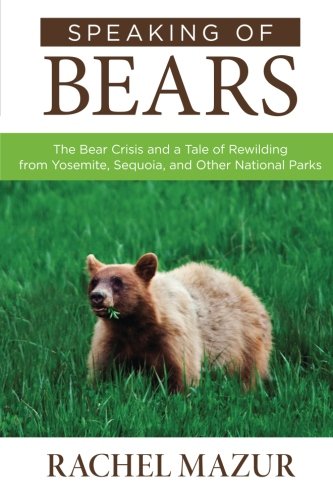Speaking Of Bears, The Bear Crisis And A Tale Of Rewilding From Yosemite, Sequoia And Other National Parks
By Kurt Repanshek on August 4th, 2015

Speaking of Bears: The Bear Crisis and a Tale of Rewilding from Yosemite, Sequoia, and Other National Parks
Author : Rachel Mazur
Published : 2015-05-01
Amazon Price : $12.61
Author : Rachel Mazur
Published : 2015-05-01
Amazon Price : $12.61
Even before the establishment of the National Park Service in 1916, wildlife issues involving predators swirled about the national parks. Grizzly bears and wolves were apex predators that preyed on deer, elk, moose, and bison. As such, they were viewed as evil, rapacious carnivores to be exterminated.
How to manage wildlife continues to be a hot0-button issue in some parks, whether the wildlife in question are piping plovers at Cape Hatteras National Seashore or Florida panthers at Big Cypress National Preserve.
But perhaps the most long-running, contentious wildlife issue in the national parks surrounds bears. It’s one that Rachel Mazur, who holds a PhD in wildlife biology and who ran the bear management program in Sequoia and Kings Canyon national parks in California, chronicles in Speaking of Bears, The Bear Crisis and a Tale of Rewilding from Yosemite, Sequoia, and Other National Parks.
Compiled from a voluminous search of published research, dozens of interviews with bear managers in the parks, and her own experiences, Dr. Mazur has come forward with a book not written for a scientific journal, but one for the general public to help the rest of us understand the history of bears in national parks.
The book is straightforward; Dr. Mazur pulls no punches. She recounts the decades of poor bear management in the parks, discussing the garbage dumps that were used to "chum" in black bears for tourists to watch, the use of bacon-wrapped-dynamite sticks by backcountry trail crews to kill troublesome bears, the parks' continued reliance on relocating habituated bears even though research showed the practice was a waste of money.
We learn about the drugs -- some good, some terribly bad -- used to knock out bears, funding challenges for bear management programs, pecking orders among the park staff that led to problems for a while.
But the author also delves into the dogged efforts by wildlife biologists and "bear technicians" in Yosemite andSequoia to find the solution that would see bears remain reliant on natural, not human, foods, and reduce bear-human conflicts. And we learn how bear canisters used, and sometimes required, in many parks with bear populations evolved.
Still, sheer numbers -- those of bears, and those of human visitors -- complicated the best of efforts to reach success in Yosemite. In 1997, Dr. Mazur points out, Steve Herrero, one of the foremost bear experts out there, wrote Yosemite's wildlife biologist, Steve Thompson:
The number of bear incidents that occurred during 1997 place Yosemite in a class by itself in terms of bear problems. No other jurisdiction that I know of has anything comparable. The extent of problems is clearly not meeting your goal of protecting wildlife (bears), nor is it keeping bears in a natural state The elevated risk of serious injury to a person means that with this number of bear incidents someone will eventually be seriously injured. It is time you be given the budget to do the job.
Speaking of Bears provides a wonderful read ... and a great service in tracking the history of black bear management in the Sierra parks, foremost, with some insights into the issues at Great Smoky Mountains National Park in North Carolina and Tennessee. Along with highlighting the problems the Park Service had in transitioning from a bear-killing agency to one that works hard to ensure bears don't become habituated to humans and reliant on their foods, it demonstrates the long-standing funding woes the agency has when it comes to management needs, and the critical need for park visitors to buy into bear management programs and work just as hard to keep foods out of the bruins' reach.
Amazon Detail : Product Description
The history, compiled from interviews with over 100 individuals, of how Yosemite, Sequoia, and Kings Canyon National Parks, all in California's Sierra Nevada, created a human-bear problem so bad that there were eventually over 2,000 incidents in a single year. Speaking of Bears is for bear lovers, national park buffs, historians, wildlife managers, biologists, policy and grant-makers, and anyone who wants to know the who, what, where, when, and why of what once was a serious human-bear problem, and the path these parks took to correct it.
The history, compiled from interviews with over 100 individuals, of how Yosemite, Sequoia, and Kings Canyon National Parks, all in California's Sierra Nevada, created a human-bear problem so bad that there were eventually over 2,000 incidents in a single year. Speaking of Bears is for bear lovers, national park buffs, historians, wildlife managers, biologists, policy and grant-makers, and anyone who wants to know the who, what, where, when, and why of what once was a serious human-bear problem, and the path these parks took to correct it.

No comments:
Post a Comment